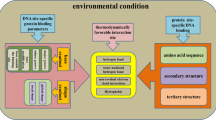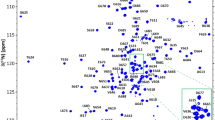Abstract
DNA mismatch repair is an excision system that removes mismatched bases chiefly generated by replication errors. In this system, MutL endonucleases direct the excision reaction to the error-containing strand of the duplex by specifically incising the newly synthesized strand. Both bacterial homodimeric and eukaryotic heterodimeric MutL proteins belong to the GHKL ATPase/kinase superfamily that comprises the N-terminal ATPase and C-terminal dimerization regions. Generally, the GHKL proteins show large ATPase cycle-dependent conformational changes, including dimerization-coupled ATP binding of the N-terminal domain. Interestingly, the ATPase domain of human PMS2, a subunit of the MutL heterodimer, binds ATP without dimerization. The monomeric ATP-bound state of the domain has been thought to be characteristic of heterodimeric GHKL proteins. In this study, we characterized the ATP-bound state of the ATPase domain from the Aquifex aeolicus MutL endonuclease, which is a homodimeric GHKL protein unlike the eukaryotic MutL. Gel filtration, dynamic light scattering, and small-angle X-ray scattering analyses clearly showed that the domain binds ATP in a monomeric form despite its homodimeric nature. This indicates that the uncoupling of dimerization and ATP binding is a common feature among bacterial and eukaryotic MutL endonucleases, which we suggest is closely related to the molecular mechanisms underlying mismatch repair.






Similar content being viewed by others
Abbreviations
- MMR:
-
Mismatch repair
- aqMutL:
-
Aquifex aeolicus MutL
- NTD:
-
N-terminal domain
- CTD:
-
C-terminal domain
- DLS:
-
Dynamic light scattering
- SAXS:
-
Small-angle X-ray scattering
References
Aarnio M et al (1999) Cancer risk in mutation carriers of DNA-mismatch-repair genes. Int J Cancer 81:214–218. doi:10.1002/(SICI)1097-0215(19990412)81:2<214:AID-IJC8>3.0.CO;2-L
Arai R, Wriggers W, Nishikawa Y, Nagamune T, Fujisawa T (2004) Conformations of variably linked chimeric proteins evaluated by synchrotron X-ray small-angle scattering. Proteins 57:829–838
Arana ME, Holmes SF, Fortune JM, Moon AF, Pedersen LC, Kunkel TA (2010) Functional residues on the surface of the N-terminal domain of yeast Pms1. DNA Repair (Amst) 9:448–457. doi:10.1016/j.dnarep.2010.01.010
Ban C, Yang W (1998a) Crystal structure and ATPase activity of MutL: implications for DNA repair and mutagenesis. Cell 95:541–552
Ban C, Yang W (1998b) Structural basis for MutH activation in E. coli mismatch repair and relationship of MutH to restriction endonucleases. EMBO J 17:1526–1534
Ban C, Junop M, Yang W (1999) Transformation of MutL by ATP binding and hydrolysis: a switch in DNA mismatch repair. Cell 97:85–97
Bergerat A, de Massy B, Gadelle D, Varoutas PC, Nicolas A, Forterre P (1997) An atypical topoisomerase II from Archaea with implications for meiotic recombination. Nature 386:414–417. doi:10.1038/386414a0
Correa EM, Martina MA, De Tullio L, Argarana CE, Barra JL (2011) Some amino acids of the Pseudomonas aeruginosa MutL D(Q/M)HA(X)(2)E(X)(4)E conserved motif are essential for the in vivo function of the protein but not for the in vitro endonuclease activity. DNA Repair (Amst) 10:1106–1113. doi:10.1016/j.dnarep.2011.08.007
Deckert G et al (1998) The complete genome of the hyperthermophilic bacterium Aquifex aeolicus. Nature 392:353–358. doi:10.1038/32831
Duppatla V, Bodda C, Urbanke C, Friedhoff P, Rao DN (2009) The C-terminal domain is sufficient for endonuclease activity of Neisseria gonorrhoeae MutL. Biochem J 423:265–277
Dutta R, Inouye M (2000) GHKL, an emergent ATPase/kinase superfamily. Trends Biochem Sci 25:24–28
Dzantiev L, Constantin N, Genschel J, Iyer RR, Burgers PM, Modrich P (2004) A defined human system that supports bidirectional mismatch-provoked excision. Mol Cell 15:31–41
Fishel R, Kolodner RD (1995) Identification of mismatch repair genes and their role in the development of cancer. Curr Opin Genet Dev 5:382–395
Fishel R et al (1993) The human mutator gene homolog MSH2 and its association with hereditary nonpolyposis colon cancer. Cell 75:1027–1038
Friedberg EC, Siede W, Walker GC, Wood RD, Schultz RA, Ellenberger T (2006) DNA repair and mutagenesis, 2nd edn. American Society for Microbiology, Washington, DC
Fujisawa T et al (2000) Small-angle X-ray scattering station at the SPring-8 RIKEN beamline. J Appl Cryst 33:797–800
Fukui K (2010) DNA mismatch repair in eukaryotes and bacteria. J Nucleic Acids 2010:260512
Fukui K, Nishida M, Nakagawa N, Masui R, Kuramitsu S (2008) Bound nucleotide controls the endonuclease activity of mismatch repair enzyme MutL. J Biol Chem 283:12136–12145
Fukui K, Shimada A, Iino H, Masui R, Kuramitsu S (2011) Biochemical properties of MutL, a DNA mismatch repair endonuclease. In: Storici F (ed) DNA repair—on the pathway to fixing DNA damage and errors. Intech, Rijeka, pp 123–142
Genschel J, Bazemore LR, Modrich P (2002) Human exonuclease I is required for 5′ and 3′ mismatch repair. J Biol Chem 277:13302–13311
Guarne A, Junop MS, Yang W (2001) Structure and function of the N-terminal 40 kDa fragment of human PMS2: a monomeric GHL ATPase. EMBO J 20:5521–5531
Guarne A, Ramon-Maiques S, Wolff EM, Ghirlando R, Hu X, Miller JH, Yang W (2004) Structure of the MutL C-terminal domain: a model of intact MutL and its roles in mismatch repair. EMBO J 23:4134–4145
Iino H, Kim K, Shimada A, Masui R, Kuramitsu S, Fukui K (2011) Characterization of C- and N-terminal domains of Aquifex aeolicus MutL endonuclease: N-terminal domain stimulates the endonuclease activity of C-terminal domain in a zinc-dependent manner. Biosci Rep 31:309–322
Iyer RR, Pluciennik A, Burdett V, Modrich PL (2006) DNA mismatch repair: functions and mechanisms. Chem Rev 106:302–323
Jiricny J, Nystrom-Lahti M (2000) Mismatch repair defects in cancer. Curr Opin Genet Dev 10:157–161 S0959-437X(00)00066-6 [pii]
Kadyrov FA, Dzantiev L, Constantin N, Modrich P (2006) Endonucleolytic function of MutLα in human mismatch repair. Cell 126:297–308
Kadyrov FA, Holmes SF, Arana ME, Lukianova OA, O’Donnell M, Kunkel TA, Modrich P (2007) Saccharomyces cerevisiae MutLα is a mismatch repair endonuclease. J Biol Chem 282:37181–37190
Kiefer F, Arnold K, Kunzli M, Bordoli L, Schwede T (2009) The SWISS-MODEL repository and associated resources. Nucleic Acids Res 37:D387–D392
Kim TG, Cha HJ, Lee HJ, Heo SD, Choi KY, Ku JK, Ban C (2009) Structural insights of the nucleotide-dependent conformational changes of Thermotoga maritima MutL using small-angle X-ray scattering analysis. J Biochem 145:199–206
Konarev PV, Volkov VV, Sokolova AV, Kock MHJ, Svergun DI (2003) PRIMUS—a Windows-PC based system for small-angle scattering data analysis. J Appl Cryst 36:1277–1282
Kozin MB, Svergun DI (2001) Automated matching of high- and low-resolution structural models. J Appl Cryst 34:33–41
Kunkel TA, Erie DA (2005) DNA mismatch repair. Annu Rev Biochem 74:681–710
Kuramitsu S, Hiromi K, Hayashi H, Morino Y, Kagamiyama H (1990) Pre-steady-state kinetics of Escherichia coli aspartate aminotransferase catalyzed reactions and thermodynamic aspects of its substrate specificity. Biochemistry 29:5469–5476
Li GM (2008) Mechanisms and functions of DNA mismatch repair. Cell Res 18:85–98
Lynch HT et al (1985) Hereditary nonpolyposis colorectal cancer (Lynch syndromes I and II). II. Biomarker Stud Cancer 56:939–951
Maruya M, Sameshima M, Nemoto T, Yahara I (1999) Monomer arrangement in HSP90 dimer as determined by decoration with N and C-terminal region specific antibodies. J Mol Biol 285:903–907. doi:10.1006/jmbi.1998.2349
Mauris J, Evans TC (2009) Adenosine triphosphate stimulates Aquifex aeolicus MutL endonuclease activity. PLoS One 4:e7175
Miyaki M et al (1997) Drastic genetic instability of tumors and normal tissues in Turcot syndrome. Oncogene 15:2877–2881. doi:10.1038/sj.onc.1201668
Modrich P (2006) Mechanisms in eukaryotic mismatch repair. J Biol Chem 281:30305–30309
Modrich P, Lahue R (1996) Mismatch repair in replication fidelity, genetic recombination, and cancer biology. Annu Rev Biochem 65:101–133
Morita R et al (2010) Molecular mechanisms of the whole DNA repair system: a comparison of bacterial and eukaryotic systems. J Nucleic Acids 2010:179594
Niedziela-Majka A, Maluf NK, Antony E, Lohman TM (2011) Self-assembly of Escherichia coli MutL and its complexes with DNA. Biochemistry 50:7868–7880. doi:10.1021/bi200753b
Pettersen EF, Goddard TD, Huang CC, Couch GS, Greenblatt DM, Meng EC, Ferrin TE (2004) UCSF Chimera—a visualization system for exploratory research and analysis. J Comput Chem 25:1605–1612. doi:10.1002/jcc.20084
Pillon MC et al (2010) Structure of the endonuclease domain of MutL: unlicensed to cut. Mol Cell 39:145–151
Pillon MC, Miller JH, Guarne A (2011) The endonuclease domain of MutL interacts with the β sliding clamp. DNA Repair (Amst) 10:87–93
Pluciennik A, Dzantiev L, Iyer RR, Constantin N, Kadyrov FA, Modrich P (2010) PCNA function in the activation and strand direction of MutLα endonuclease in mismatch repair. Proc Natl Acad Sci USA 107:16066–16071
Prodromou C, Roe SM, O’Brien R, Ladbury JE, Piper PW, Pearl LH (1997) Identification and structural characterization of the ATP/ADP-binding site in the Hsp90 molecular chaperone. Cell 90:65–75 S0092-8674(00)80314-1 [pii]
Prodromou C et al (2000) The ATPase cycle of Hsp90 drives a molecular ‘clamp’ via transient dimerization of the N-terminal domains. EMBO J 19:4383–4392. doi:10.1093/emboj/19.16.4383
Pugh BF, Cox MM (1988) High salt activation of recA protein ATPase in the absence of DNA. J Biol Chem 263:76–83
Sacho EJ, Kadyrov FA, Modrich P, Kunkel TA, Erie DA (2008) Direct visualization of asymmetric adenine-nucleotide-induced conformational changes in MutLα. Mol Cell 29:112–121
Schwede T, Kopp J, Guex N, Peitsch MC (2003) SWISS-MODEL: an automated protein homology-modeling server. Nucleic Acids Res 31:3381–3385
Svergun DI (1992) Determination of the regularization parameter in indirect-transform methods using perceptual criteria. J Appl Crystallogr 25:495–503
Svergun D, Barberato C, Koch MHJ (1995) CRYSOL—a program to evaluate X-ray solution scattering of biological macromolecules from atomic coordinates. J Appl Cryst 28:768–773
Svergun DI, Petoukhov MV, Koch MH (2001) Determination of domain structure of proteins from X-ray solution scattering. Biophys J 80:2946–2953. doi:10.1016/S0006-3495(01)76260-1
Svergun DI, Shtykova EV, Volkov VV, Feigin LA (2011) Small-angle X-ray scattering, synchrotron radiation, and the structure of bio- and nanosystems. Crystallogr Rep 56:725–750
Terasawa K, Minami M, Minami Y (2005) Constantly updated knowledge of Hsp90. J Biochem 137:443–447. doi:10.1093/jb/mvi056
Volkov VV, Svergun DI (2003) Uniqueness of ab initio shape determination in small-angle scattering. J Appl Cryst 36:860–864
Wigley DB, Davies GJ, Dodson EJ, Maxwell A, Dodson G (1991) Crystal structure of an N-terminal fragment of the DNA gyrase B protein. Nature 351:624–629. doi:10.1038/351624a0
Wriggers W, Birmanns S (2001) Using situs for flexible and rigid-body fitting of multiresolution single-molecule data. J Struct Biol 133:193–202. doi:10.1006/jsbi.2000.4350
Yamamoto T, Iino H, Kim K, Kuramitsu S, Fukui K (2011) Evidence for ATP-dependent structural rearrangement of nuclease catalytic site in DNA mismatch repair endonuclease MutL. J Biol Chem 286:42337–42348. doi:10.1074/jbc.M111.277335
Yang W (2007) Human MutLα: the jack of all trades in MMR is also an endonuclease. DNA Repair (Amst) 6:135–139
Yokoyama S et al (2000) Structural genomics projects in Japan. Nat Struct Biol 7(Suppl):943–945. doi:10.1038/80712
Zhang Y et al (2005) Reconstitution of 5′-directed human mismatch repair in a purified system. Cell 122:693–705. doi:10.1016/j.cell.2005.06.027
Acknowledgments
The authors thank Kayoko Matsumoto for the experiment involving overexpression of the proteins, Aimi Osaki for the assistance of protein purifications. Authors also thank Masao Inoue for his critical reading of this manuscript. The SAXS experiments in this study were performed at BL45XU in SPring-8 (Proposals 20110033 and 20120009). This work was supported by Management Expenses Grants from the government to RIKEN.
Author information
Authors and Affiliations
Corresponding author
Additional information
Communicated by F. Robb.
Electronic supplementary material
Below is the link to the electronic supplementary material.
Rights and permissions
About this article
Cite this article
Iino, H., Hikima, T., Nishida, Y. et al. Small-angle X-ray scattering analysis reveals the ATP-bound monomeric state of the ATPase domain from the homodimeric MutL endonuclease, a GHKL phosphotransferase superfamily protein. Extremophiles 19, 643–656 (2015). https://doi.org/10.1007/s00792-015-0745-2
Received:
Accepted:
Published:
Issue Date:
DOI: https://doi.org/10.1007/s00792-015-0745-2




